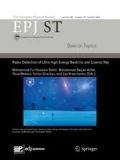Abstract
Polyelectrolyte complexes (PECs) have a broad range of promising applications as soft materials due to their self-assembly and diversity of structure and chemical composition. Peptide polymer PECs are highly biocompatible and biodegradable, making them particularly useful for encapsulation of food additives and flavors, micellar drug delivery, medical and underwater adhesives, fetal membrane patches, and scaffolds for cell growth in tissue engineering. While parameters affecting PEC formation and stability in regards to charge effects are well researched, little is known about the effects of van der Waals interactions, hydrogen bonding, and secondary structure in these materials. Peptide chirality provides a unique opportunity to manipulate PEC phase to modulate the amount of solid-like (precipitate) or liquid-like (coacervate) character by influencing hydrogen bonding interactions among peptide chains. In previous work, we showed that chiral peptides form solid complexes, while complexes with even one racemic peptide were fluid. This raised the interesting question of how long a homochiral sequence must be to result in solid phase formation. In this work, we designed chiral patterned peptides of polyglutamic acid and polylysine ranging from 50 to 90% L-chiral residues with increasing numbers of sequential L-chiral residues before a chirality change. These polymers were mixed together to form PECs. We observed that 8 or more sequential L-chiral residues are necessary to achieve both the appearance of a precipitate phase and sustained β-sheets in the complex, as determined by optical imaging and FTIR Spectroscopy. Less homochiral content results in formation of a coacervate phase. Thus, we show that chiral sequence can be used to control the phase transition of PECs. Understanding how to manipulate PEC phase using chiral sequence as presented here may enable tuning of the material properties to achieve the desired mechanical strength for coatings and polymer brushes, or the most effective molecular release kinetics for drug delivery applications, for example.
Similar content being viewed by others
References
J.V.D. Gucht, E. Spruijt, M. Lemmers, M.A. Cohen Stuart, J. Colloid Interface Sci. 361, 407 (2011)
S.L. Perry, L. Leon, K.Q. Hoffmann, M.J. Kade, D. Priftis, K.A. Black, D. Wong, R.A. Klein, C.F. Pierce III, K.O. Margossian, J.K. Whitmer, J. Qin, J.J. de Pablo, M. Tirrell, Nat. Commun. 6, 6052 (2015)
D. Priftis, N. Laugel, M. Tirrell, Langmuir 28, 15947 (2012)
D. Priftis, M. Tirrell, Soft Matter 8, 9396 (2012)
C.G. de Kruif, F. Weinbreck, R. de Vries, Curr. Opin. Colloid & Interface Sci. 9, 340 (2004)
M. Fändrich, C.M. Dobson, EMBO J 21, 5682 (2002)
W. Dzwolak, R. Ravindra, C. Nicolini, R. Jansen, R. Winter, J. Am. Chem. Soc. 126, 3762 (2004)
J.-H. Fuhrhop, M. Krull, G. Büldt, Angew. Chem. Int. Ed. Engl. 26, 699 (1987)
M.A. Augustin, Y. Hemar, Chem. Soc. Rev. 38, 902 (2009)
A. Madene, M. Jacquot, J. Scher, S. Desobry, Inter. J. Food Sci. Technol. 41, 1 (2006)
O. Azzaroni, J. Polym. Sci. A Polym. Chem. 50, 3225 (2012)
R.J. Stewart, C.S. Wang, H. Shao, Adv. Colloid Interface Sci. 167, 85 (2011)
D.S. Hwang, H. Zeng, A. Srivastava, D.V. Krogstad, M. Tirrell, J.N. Israelachvili, J.H. Waite, Soft Matter 6, 3232 (2010)
L.K. Mann, R. Papanna, K.J. Moise Jr., R.H. Byrd, E.J. Popek, S. Kaur, S.C.G. Tseng, R.J. Stewart, Acta Biomaterialia 8, 2160 (2012)
R.J. Ono, A.L.Z. Lee, W. Chin, W.S. Goh, A.Y.L. Lee, Y.Y. Yang, J.L. Hedrick, ACS Macro Lett. 4, 886 (2015)
J.H. Ortony, S.-H. Choi, J.M. Spruell, J.N. Hunt, N.A. Lynd, D.V. Krogstad, V.S. Urban, C.J. Hawker, E.J. Kramer, S. Han, Chem. Sci. 5, 58 (2013)
K.A. Black, D. Priftis, S.L. Perry, J. Yip, W.Y. Byun, M. Tirrell, ACS Macro Lett. 3, 1088 (2014)
E.J. Chung, M. Tirrell, Adv. Healthcare Mater. 4, 2408 (2015)
S. Lankalapalli, V.R.M. Kolapalli, Indian J. Pharm. Sci. 71, 481 (2009)
J.H. Kim, T. Ramasamy, T.H. Tran, J.Y. Choi, H.J. Cho, C.S. Yong, J.O. Kim, Asian J. Pharm. Sci. 9, 191 (2014)
R. Trivedi, U.B. Kompella, Nanomedicine (Lond) 5, 485 (2010)
I.-C. Liao, A.C.A. Wan, E.K.F. Yim, K.W. Leong, J. Control Release 104, 347 (2005)
C.-H. Kuo, L. Leon, E.J. Chung, R.-T. Huang, T.J. Sontag, C.A. Reardon, G.S. Getz, M. Tirrell, Y. Fang, J. Mater. Chem. B 2, 8142 (2014)
E.K.F. Yim, I.-C. Liao, K.W. Leong, Tissue Eng. 13, 423 (2007)
Q. Wang, J. B. Schlenoff, Macromolecules 47, 3108 (2014)
C. Tapia, Z. Escobar, E. Costa, J. Sapag-Hagar, F. Valenzuela, C. Basualto, M.N. Gai, M. Yazdani-Pedram, Eur. J. Pharm. Biopharm. 57, 65 (2004)
Y.P. Myer, Macromolecules 2, 624 (1969)
D. Priftis, X. Xia, K.O. Margossian, S.L. Perry, L. Leon, J. Qin, J.J. de Pablo, M. Tirrell, Macromolecules 47, 3076 (2014)
C. Baiz, M. Reppert, A. Tokmakoffm, Ultrafast Infrared Vibrational Spectroscopy (CRC Press, 2012)
K.Q. Hoffmann, S.L. Perry, L. Leon, D. Priftis, M. Tirrell, J.J. de Pablo, Soft Matter 11, 1525 (2015)
G.B. Fields, R.L. Noble, Int. J. Pept. Protein Res. 35, 161 (1990)
N.J. Greenfield, G.D. Fasman, Biochemistry 8, 4108 (1969)
J.T. Vivian, P.R. Callis, Biophys. J. 80, 2093 (2001)
L. Richert, Y. Arntz, P. Schaaf, J.-C. Voegel, C. Picart, Surf. Sci. 570, 13 (2004)
M. Doi, S.F. Edwards, The Theory of Polymer Dynamics (Clarendon Press, 1988)
B.P. Chan, K.W. Leong, Eur. Spine J. 17, 467 (2008)
Author information
Authors and Affiliations
Corresponding author
Rights and permissions
About this article
Cite this article
Pacalin, N., Leon, L. & Tirrell, M. Directing the phase behavior of polyelectrolyte complexes using chiral patterned peptides. Eur. Phys. J. Spec. Top. 225, 1805–1815 (2016). https://doi.org/10.1140/epjst/e2016-60149-6
Received:
Revised:
Published:
Issue Date:
DOI: https://doi.org/10.1140/epjst/e2016-60149-6




